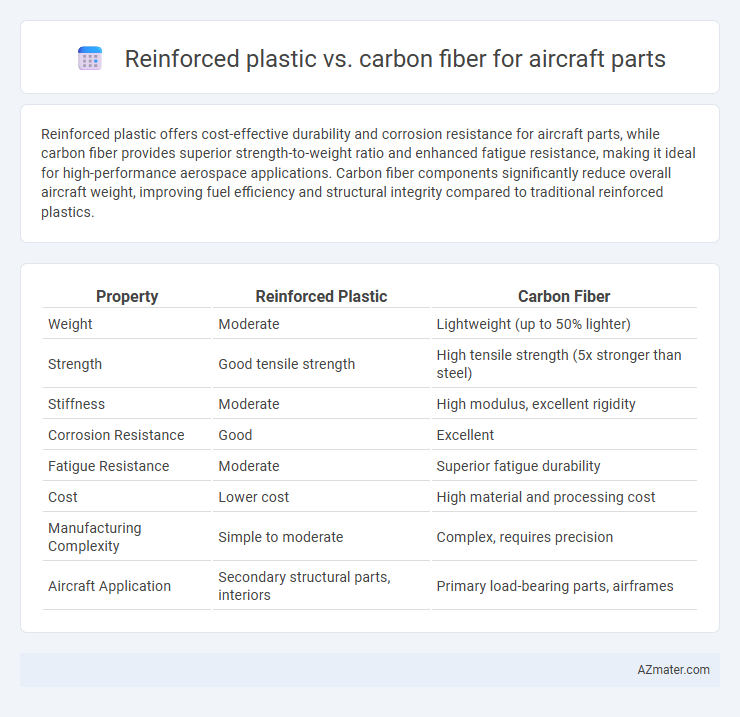Reinforced plastic offers cost-effective durability and corrosion resistance for aircraft parts, while carbon fiber provides superior strength-to-weight ratio and enhanced fatigue resistance, making it ideal for high-performance aerospace applications. Carbon fiber components significantly reduce overall aircraft weight, improving fuel efficiency and structural integrity compared to traditional reinforced plastics.
Table of Comparison
| Property | Reinforced Plastic | Carbon Fiber |
|---|---|---|
| Weight | Moderate | Lightweight (up to 50% lighter) |
| Strength | Good tensile strength | High tensile strength (5x stronger than steel) |
| Stiffness | Moderate | High modulus, excellent rigidity |
| Corrosion Resistance | Good | Excellent |
| Fatigue Resistance | Moderate | Superior fatigue durability |
| Cost | Lower cost | High material and processing cost |
| Manufacturing Complexity | Simple to moderate | Complex, requires precision |
| Aircraft Application | Secondary structural parts, interiors | Primary load-bearing parts, airframes |
Introduction to Aircraft Material Selection
Reinforced plastic and carbon fiber are critical materials in aircraft part manufacturing, chosen for their high strength-to-weight ratios and durability. Reinforced plastics, often composed of fiberglass or aramid fibers embedded in a polymer matrix, offer cost-effective corrosion resistance and ease of fabrication. Carbon fiber composites provide superior stiffness and tensile strength, enhancing fuel efficiency and performance in aerospace applications.
Overview of Reinforced Plastics
Reinforced plastics, commonly used in aircraft parts, consist of a polymer matrix embedded with fibers such as glass or aramid to enhance strength and durability. These composites offer excellent corrosion resistance, lightweight properties, and cost-effectiveness compared to traditional metals, making them ideal for non-structural components. Their versatility allows customization for specific performance requirements, contributing to improved fuel efficiency and overall aircraft performance.
Understanding Carbon Fiber Composites
Carbon fiber composites offer superior strength-to-weight ratios compared to traditional reinforced plastics, making them ideal for critical aircraft parts that demand high structural performance. Their unique molecular structure provides exceptional stiffness, fatigue resistance, and corrosion resistance, enhancing overall aircraft durability and fuel efficiency. Advanced manufacturing techniques enable precise layering of carbon fibers within composite matrices, optimizing load distribution and minimizing material waste.
Strength and Durability Comparison
Carbon fiber exhibits superior strength-to-weight ratio compared to reinforced plastic, making it ideal for high-stress aircraft parts requiring maximum structural integrity. Reinforced plastic offers good durability with resistance to corrosion and impact, but it generally lacks the tensile strength and fatigue resistance of carbon fiber composites. Carbon fiber's enhanced fatigue endurance and stiffness ensure longer lifespan and improved performance under dynamic flight conditions, surpassing reinforced plastic in demanding aerospace applications.
Weight Reduction Benefits
Carbon fiber offers superior weight reduction benefits over reinforced plastic due to its higher strength-to-weight ratio, significantly improving fuel efficiency and aircraft performance. Reinforced plastics, while lighter than traditional metals, often lack the rigidity and durability of carbon fiber composites, limiting their effectiveness in critical load-bearing parts. Utilizing carbon fiber in aircraft construction reduces overall weight, leading to decreased emissions and lower operational costs.
Cost Analysis: Reinforced Plastic vs Carbon Fiber
Reinforced plastic offers lower material and manufacturing costs compared to carbon fiber, making it a budget-friendly choice for less critical aircraft parts. Carbon fiber delivers superior strength-to-weight ratio and durability, but its high raw material and processing expenses significantly increase overall production costs. Cost analysis reveals reinforced plastic benefits from reduced tooling and repair costs, while carbon fiber demands investment in specialized equipment and skilled labor.
Manufacturing Process Differences
Reinforced plastic manufacturing involves layering fiberglass or other fibers with a thermosetting resin, cured through heat and pressure in molds, enabling easier shaping and lower production costs. Carbon fiber production requires precise alignment of carbon filaments within a polymer resin matrix, curing in autoclaves under high pressure and temperature to achieve superior strength-to-weight ratios. The manufacturing process of carbon fiber is more complex, time-consuming, and costly, but it results in aircraft parts with enhanced durability, stiffness, and fuel efficiency compared to reinforced plastics.
Performance in Extreme Conditions
Carbon fiber exhibits superior performance in extreme conditions for aircraft parts due to its high strength-to-weight ratio and excellent fatigue resistance at elevated temperatures, outperforming reinforced plastics. Reinforced plastics, while cost-effective and corrosion-resistant, tend to degrade under intense thermal and mechanical stress, limiting their use in critical high-stress aircraft components. The thermal stability and stiffness of carbon fiber composites ensure enhanced durability and structural integrity during demanding flight operations and harsh environmental exposure.
Maintenance and Longevity Considerations
Reinforced plastics offer ease of maintenance due to their resistance to corrosion and lower repair costs, making them suitable for aircraft parts exposed to environmental stress. Carbon fiber provides superior longevity with higher strength-to-weight ratios and fatigue resistance, but demands specialized inspection and repair techniques, increasing maintenance complexity and costs. Selecting between reinforced plastic and carbon fiber relies on balancing durability requirements with available maintenance infrastructure to optimize aircraft part life cycles.
Industry Trends and Future Innovations
Reinforced plastic and carbon fiber dominate aircraft part manufacturing, with carbon fiber favored for its superior strength-to-weight ratio and increasing use in next-gen aircraft like the Boeing 787 and Airbus A350. Industry trends show a shift toward hybrid composites combining reinforced plastics with carbon fibers to optimize cost and performance while improving fuel efficiency and reducing emissions. Future innovations focus on enhancing carbon fiber recyclability and developing advanced resin systems to expand applications and lifespan in aerospace components.

Infographic: Reinforced plastic vs Carbon fiber for Aircraft part
 azmater.com
azmater.com